
Journal of Clinical Toxicology
Open Access
ISSN: 2161-0495
+44 1478 350008

ISSN: 2161-0495
+44 1478 350008
Review Article - (2023)Volume 13, Issue 2
Objective: Egyptians officially divided their territory in "Two Lands" or (tAwy) (name in hieroglyphs) TAUY, the Upper and Lower Egypt, distinguishing also between the dark fertile land called (kmt) (name in hieroglyphs) Kemet, the official name of their country, considered the Beloved land or (tA-mri)(name in hieroglyphs) Ta-mery, and the arid desert landscape” or (dSrt) )(name in hieroglyphs) Deshret. We’ll try to determine what king of pharmacopoeia they obtained from both types of soils, related to their gods and symbolisms. The red color of the desert represented Seth, god of evil, chaos, diseases and death while the Osiris’ black and green colors indicated regeneration and continuous rebirth.
Methods: From the Egyptian sources we could establish that the rich Black Land provided vegetal drugs, including alkaloids and chemical substances used in a complicated polypharmacy. The invention of these drugs was identified with Toth, a moon-god and Pharmacos later associated with the Corpus Hermeticum, who also taught them the rites to collect roots and plants. They completed medical preparations with minerals and metals from the Red Land as the gold, precious material that transformed an inert being into an eternal god Ra.
Results: Egypt, the country of pharmaca, was also the cradle of knowledge about stones and from Kemet, the “Black Land art” derived the words “chemical” and “alchemy”. In Ptolemaic Alexandria, from other sciences as astronomy derived astrology and horoscopes and even medicine was subordinated to astrology, astral beliefs and alchemy. Based on the comprehension of the fire regime and the purification of individual substances, this popular pseudo-science, mostly often called the ‘Sacred Art’ by early Greco-Egyptian alchemists due to its religious and practical aspects, provided fundamental pillars for modern chemical industries, metallurgy and physics and influenced the Western art and sciences: psychology, psychiatry, astrology, esoteric tradition, mysticism and medicine.
Conclusion: While the initiation schools in the country elaborated miraculous remedies, poisons and magical filters, the philosophical system was connected to Hermes Trismegistus and developed three main activities: the transmutation of vile metals into noble metals, the creation of the Philosopher’s stone to obtain youth and longevity in a perfect and eternal state, and later the development of an Elixir of Life or panacea, capable of curing all illnesses and prolong life.
In this context a notable, strange and legendary figure was Bolus of Mendes, who adopted the name of Pseudo Democritus, active in Alexandria around 200 BC. He was the prototype of alchemist, renowned as “magician” (magoi) in late antiquity, and developed an approach to physics, partly scientific, partly occultist, based specially in the sympathy notion.
Tauy or two lands; Egypt; Black and red lands; The Country of pharmaca; Alchemy
The Ancient Egyptians named their country (kmt) (name in hieroglyphs) Kemet which means “Black Land”, referring however only to the fertile land around the Nile.
This narrow alluvial soil, considered a gift of the River, ensured people welfare and prosperity.
Like a giant snake, the Nile slithers through 6,800 km of the driest desert land on Earth to create a narrow green valley and to reach the sea.
Regarded as the longest river in the world, if measured from its first source (Kagea River), it flows northwards from its main sources in Lake Victoria, and goes on its long journey towards the Mediterranean Sea [1].
For a long time, Egyptians had not known anything about the River first source and Alexander the Great, when had reached Egypt sent at the Aristotle’s request a scientific expedition to Ethiopia in order to discover the causes of the flooding of the Nile (Lucan, The Civil War; Photius, Bibliotheca or Myriobiblios Cod. 2489, 441 b).
It had been a subject of constant speculation (Herodotus 2, 19) until the Lyceum could clarify the flood interpretations proposed by scientists [2].
The native plants grew in the black silt and the green valley was called the “Beloved Land” (tA-mri) (name in hieroglyphs) Tamery, in contrast to the desolation of the “Red Land” (dSrt) (name in hieroglyphs) Deshret (Figure 1).
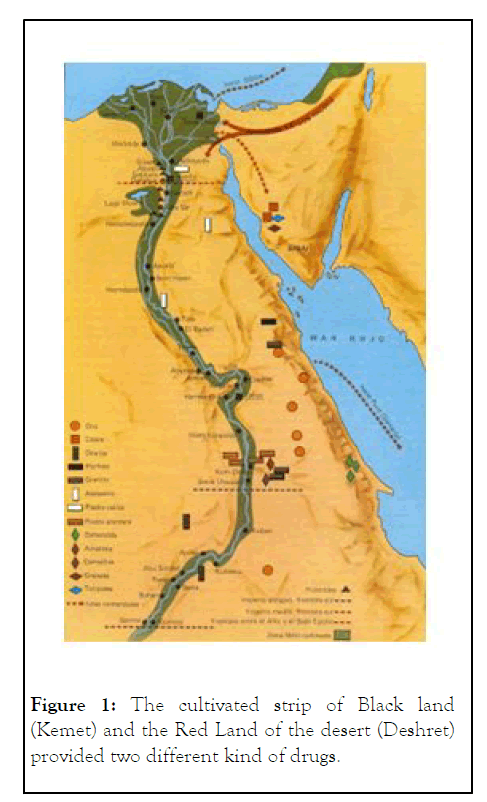
Figure 1: The cultivated strip of Black land (Kemet) and the Red Land of the desert (Deshret) provided two different kind of drugs.
This aride landscape spreads to the rocky cliffs bordering the Nile and represents a sudden transition from the rich farmland to barren wasteland, defined by the ochre colour of the sand and the red earth of Deshret, from which derives the word “desert”.
Into this wilderness did live the foreign peoples, a domain of death and devastation? Despite this place was something to be feared, Egyptians took away from it minerals to be used among others, as medically useful substances.
In their system of symbols, the red colour represented Seth, the god of evil, chaos and death who wreak epidemics and diseases while the Osiris’black and green colors symbolized regeneration and continuous rebirth.
The whole land of the country surface, including both soil types, was usually called (tAwy) hieroglyphs Tauy in extenso, the Two Lands divided in Upper and Lower Egypt, displaying a disturbing duality. Later, with an evident egocentricity, Greeks called this territory Aegyptus, from ancient Greek Aígyptos (Αἴγυπτος), that means ‘beyond the Aegean’, as it is named nowadays.
Valuing biodiversity and ecosystem obtained from these two different kinds of lands, we will review the complex pharmacopeia of this country, linked to pharmacy and alchemy, adapted to geography, to illustrate their derivations in the use of metallurgy. First we will describe the use of drugs, minerals, cosmetics and other arts in medicine and secondly we will try to explain the role of ancient Graeco-Egyptian alchemy at the beginning, that need to be understood as an amalgamation of magic, science and religion with mystical and ritualistic elements derived from the ancient Egyptian traditions and knowledge.
Sources review
Pharmaca and the geographical environment: A diverse flora and fauna grew in this perfect habitat and the Egyptian peasants have tried to be self-sufficient, producing their own food, clothing, drugs and remedies. The vegetation, very abundant, had included date palm trees, sycamore, tamarisk, acacia, carob and fig trees and many of these plants were used to make medicines. The arable farming, composed by cereals, vegetables, fruit and fiber plants, was also assigned to this purpose (Figure 2).
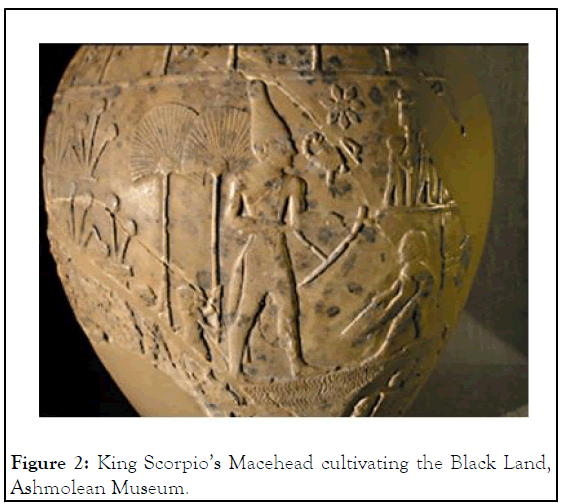
Figure 2: King Scorpio’s Macehead cultivating the Black Land, Ashmolean Museum.
Archaic medicine applied three therapeutic methods: diet, surgery and, above all, pharmaca, developed in a perfect symbiosis with the geographical environment. All parts of the edible vegetables obtained from this rich black land, stems, leaves, seeds, fruit, bark, gums and juice were regarded as useful to compose appropriated substances, because men have learnt what they can do from Nature lessons and from animal behavior. Around 700 prescriptions or recipes contain herbal remedies in the Ebers Papyrus (ca. 1500 BC.), the most famous and the longest papyrus, dated on the Dynasty 18. Natural, aromatic and edible products, such as cereals, fruits, flowers, many parts of trees are identified as the only available drugs, completed with some simple chemical substances with clear pharmacological effects: alkaloids and efficacious compounds contained atropine, quinine, morphine, opium, papaverine and digitalis, the last one applied to heart disease. Botany and herbal medicine were closely connected because they both studied and used the same ingredients and extracts. Every plant with an active principle, frequently unknown was selected for its qualities and efficacy using suitable extraction methods.
Vegetal materials for particular treatments were prepared and administered in various ways: by ingestion, pills, potions, decoctions, filtrates, tablets, blouses, infusions; in case of internal intakes, physicians applied electuaries, a powdered drugs made into a paste with honey or syrup, enemas, emetics, suppositories; and externally they used, plugs, plasters, bandages, ointments, salves, poultices, eye drops, drags, fumigations, inhalations and antidotes. Herbal remedies were often mixed, depending on their solubility, with water, essential oils or alcoholic liquids, including in their fermentation wine or beer, beverages, especially wine, that “attaint an alcohol concentration of 10-20%, sufficient for the extraction of alkaloids”. Many vegetable drugs have been used by their active principles, among them the mandrake, with aphrodisiac and narcotic properties and pain-killer [3], stramonium, white poppy, lotus belladonna and henbane also powerfully sleep-inducing and narcotics; laudanum and hellebore with analgesic effects; Withania somnifera (L.) and persea (Mimusops schimperi) with sedative and antispasmodic activities, castor oil used as a stimulant laxative and colocynth the most violent purgative. There were others more or less harmless: aniseed (Eb. 235, 267, 633), cumin and thyme with sedative properties (Eb. 5=Hearst 55; grenades, and turpentine, anthelmintics to expel parasites, absinthe an emetic, wild lettuce, a masculine invigorating but soporific at the same time like cardamom and sycamore. The incense burning in temples and palaces acted as an antiseptic, while hemp, whose waste was taken to make the kipry, was a strong psycho-active drug employed in the religious ceremonies. Grapes, moringa and balanita were applied in the case of urinary disorders; raisins, cumin, acacia, dates and figs for colds; saffron against fatigue. Various parts of willow, growing in the gardens, canals and river banks were applied to prepare different types of drugs as well as papyrus, linen, aloe, fennel, myrtle, etc. Tamarisk was a substitute for salt; garlic, onion, pepper and mustard were stimulating for their strong odor and bitter white radish was effective in waking up sluggish people [4].
However, a parallel dreckapotheke or copropharmacy composed of different unclean materials such as manure, animal urine and spider webs was also established. Readily available when it could be collected from domestic animals, zootherapy from wild animals could become dangerous as they had to be hunt, although it has finally finished in an active trade of wildlife. Unpleasant or impure substances were used to repel evil spirits installed inside the body and to come out of it. Nevertheless, it was impossible to evaluate their therapeutic effectiveness as a result of the Egyptian tendency to polypharmacy and, due to drug interaction; it could be hard to determine which individual substance was the most significant and fitting for the syndrome. The selection of animals or plants was leaded frequently by principles of isopathy or sympathy, in a search for an identical disease producing agent (similia similibus). Without knowing the benefit of a given kind of medication, they attempted merely to attract their desirable qualities and virtues.
Numerous vegetables used for mummification were acclimatized in the Delta region, growing in the ‘Priests and embalmers’ gardens’, such as: cotton, chamomile and pyrethrum varieties with insecticide virtues, flax and colocynth grains, the Aster family or Compositae flowers, Solanaceae (Nicotiana sp.) and Amaryllidaceae (Narcisus Tazetta), lotus and other plants with strong fragrance and specific virtues. Many other imported trees including cypress, oak, pine, fir and tragacanth gums, frankincense and myrrh were also employed. Plants sacred to the Egyptians, grew in the ‘Divine Countryside’ of Bubastis, one of the capitals of the Libyan Dynasty. They perfumed the air, when diluted in bark mucilages, and served to ward off the annual plague vectors in the summer heat preceding the flood. That field was presided by the Left Eye of Horus, what explains the role of the Moon in the vegetable growth.
Thoth, the Egyptian equivalent to Hermes, a great Moon-god and Pharmacos (φαρμακός) [5], (Figure 3) invented the drugs and the rites performed by magicians and herbalists to collect roots and plants. Being a healer, he knew the miraculous virtues of simples and their relationship with the different nature kingdoms and constellations [6]. The materia medica, composed of plants, perfumes, metals and foreign products or exotic plants was introduced in the country by pharaohs to improve the citizens’ chances of healing. The secrets and knowledge of simples and their ‘mysterious sympathies’ were mastered by druggists and Alexandrian perfumers, and even herbalists (Figure 4) who through generations preserved these preparations in proper alabaster jars or amphorae [7]. Thoth’s sacred secrets were transmitted to Imhotep and later this tradition passed on to Hermes and Asklepios, gods associated with the Corpus Hermeticum [8-10].
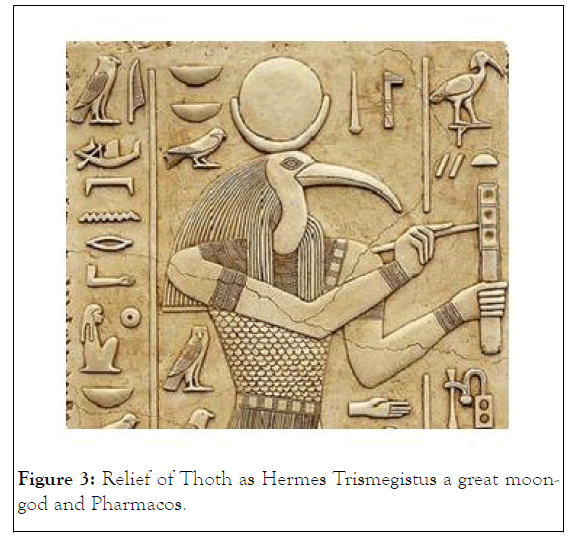
Figure 3: Relief of Thoth as Hermes Trismegistus a great moongod and Pharmacos.
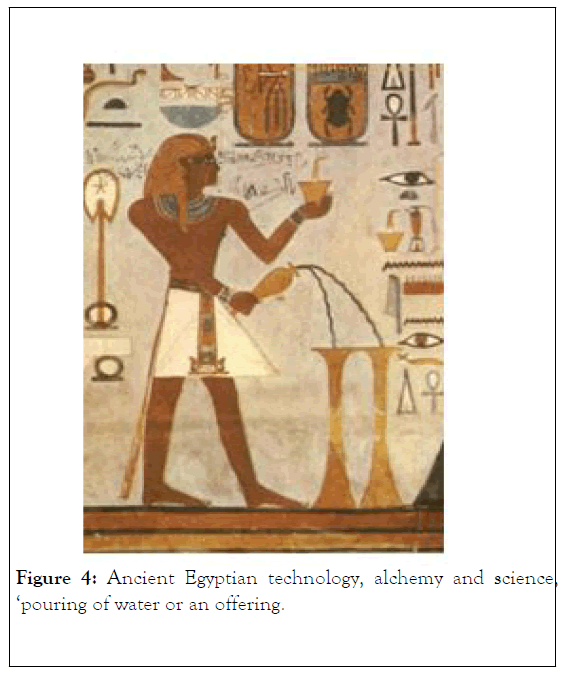
Figure 4: Ancient Egyptian technology, alchemy and science, ‘pouring of water or an offering.
The use of minerals for medical preparations
This pharmacopoeia, completed by mineral and metal medical preparations, employed usual ingredients extracted from the Red Land as gold, highly appreciated, and other metals and alloys, electrum, alum, copper, salt, charcoal, salts of lead, calamite, hematite, magnetite, alabaster [11]. Gold, considered as the unalterable flesh of Ra, represented the brightness of its beams transported to the earth. By covering a mummy with this precious metal, first the king and then the other mortal beings, would recover their vital faculties. Their corpses were thus transformed into pure gold, like Osiris (Figure 5), so as the inert deceased inherited eternal life as a god. “This complex metalliferous theology extended to the ‘Golden reward’, a gift of life given by pharaohs to noblemen, to ensure their survival” and the resurrection as eternal spirit. In this context one that traded with divine gold, in spite of the religious interdiction, suffered severe punishments.
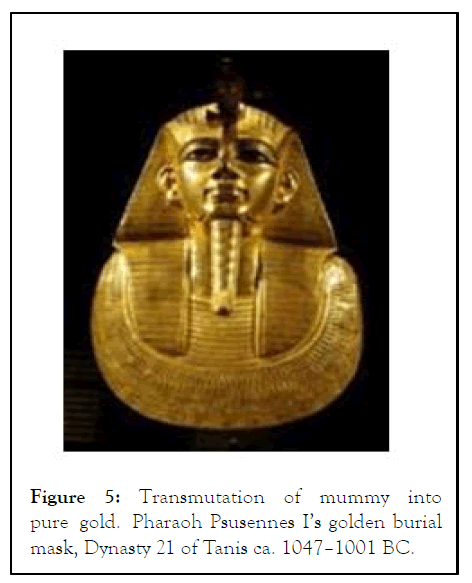
Figure 5: Transmutation of mummy into pure gold. Pharaoh Psusennes I’s golden burial mask, Dynasty 21 of Tanis ca. 1047–1001 BC.
But during the New Kingdom, expansion toward foreign countries and the commercial traffic demanded payments in gold. Later on, when Greek mercenaries arrived, pharaohs had to pay them with coins, previously unknown to Egyptians. Then the religious symbolism changed, as gold had started to be used for transactions as a vile metal. Its divine value remained unaltered inside the temples but outside them it kept only its profane purchasing power. On the other hand, two caustic substances, the yellow orpiment, named arrenikê or arsenikon and realgar, very similar minerals and both arsenic sulfide [12], were widely used in attempts of transmutation various substances into gold.
Mixed with natron, they produced toxic arsenic trioxide, the ‘burning poison’. Blue greenish chrysocolla (hydrated copper silicate) was used to solder up gold and malachite, but as other green minerals it was thought to enhance virility, while red jasper and carnelian indicated cholera and violence. ‘Divine water’ or ‘sulfur water’, used early in alchemy by Zosimus and Bolus of Mendes, was very often employed in order to process several minerals or metals and these liquids were adopted both to treat ores and to dye base metals.
The most famous Egyptian make-up, the black kohl, made of galena (lead sulfide) mixed with crushed antimony, reduced eye infections and perverse intentions and was also considered as an ocular prophylactic aid such as green chrysocolla. Egyptians used antimony sulfide as lipstick, called simmi, mixing it with metallic antimony or antimony trioxide, arsenic sulfide realgar, red mercury sulfide or cinnabar and also with sulfur in balms and ointments (Figure 6).
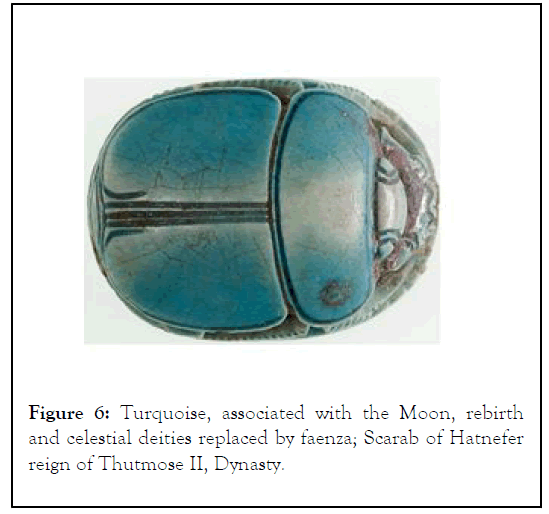
Figure 6: Turquoise, associated with the Moon, rebirth and celestial deities replaced by faenza; Scarab of Hatnefer reign of Thutmose II, Dynasty.
Eye diseases were still cured with calamine, that on calcination gives zinc oxide, or with powdered malachite, an anti-bacterial agent that inhibited staphylococcus and Pseudomonas areruginosa, due to traces of copper. It was also applied on a fetid burn (Eb. 491), an oral inflammation or a chest wound.
Other drugs containing metalloids such as arsenic and antimony, a Latin corruption of an Arabic word with symbol Sb (from Latin: stibium), were employed as pharmacological stimulants against lethargy including saffron metal [13]. Alum, a double sulphate and a name derived from the god Amun, via the Greek form Ammon, such as the ammonium salt (salt of Amun), was recommended as tonic and astringent but also used as wound healer and to cure ear sores and abrasions. Both types of alum, aluminium potassium sulfate, extracted from rocks, whose adverse effects included eye or skin irritations, sometimes hemorrhagic gastritis and serious disorders, and laminated alum, trichitis, typical of Egypt were the most widely used and traded in Antiquity. Trichitis, considered an excellent medicine, was recommended for its antiseptic and astringent action, as well as for other applications, especially purgatives and deodorants. The toxic metals-mercury, lead and copper-were known by alchemists, but they were surely unaware of their harmful effects or perhaps they did not know how to fight with the results. Nitro or natrun (mineral trona), found as a salt-like crust on rocks [14] in Egyptian Hsmn (name in hieroglyphs), was used for mummification. Considered as Hathor’s emanation in the Ritual of embalming, natrun or natron, derived from the Ancient Egyptian word (ntry), nTr (i) (name in hieroglyphs) or nṯry (be divine) and used in the modern chemical symbol for sodium, Na, was the divine product by excellence because the first operation consisted of washing, disinfected with palm wine and desiccated the dead body, covered entirely over with natrun for him to be defatted. After that the deceased would join the gods in the underworld becoming immortal and unchangeable (Edfu VI, 244, 1-2). Natron, Bd (name in hieroglyphs) created out of ash from plants that growing in salt marshes (called halophytic plants) or mined from natural deposits, was a mixture of sodium carbonate, sodium bicarbonate, chloride and sulfate. Moreover, when exposed to moisture, the carbonate in natron increases pH (raises alkalinity), which creates a hostile environment for bacteria. Its osmotic or remarkable penetrating power reduced inflammation, by attracting and casting out the fluids and have been used widely as an antiseptic and oral disinfectant for superficial infections. Common salt HmAt (name in hieroglyphs) (sodium chloride) also called Lower Egyptian salt, produced by evaporation of sea water, was alternatively employed for mummification. It’s hot solutions were soft emetics and salt itself was also used in local applications for cure of eye, ear and skin ailments (Eb. 545, 715).
Turquoise, mfkAt or mfkt, (name in hieroglyphs) a highly sought-after mineral from the mines at Sinai, was valued for its color and fragility. It was associated with rebirth and the celestial deities such as Hathor, Isis, Nephftys and Nut, the mother night. Nut was related with the Moon who fed Ra, born in a turquoise lake. Turquoise was however replaced, because of its high value, by the ceramic faenza or THnt (name in hieroglyphs) which was manufactured with the same brightness and luminosity (Figure 5). The food provided for Osiris in the Afterlife, as an astral being, was gold of eternity and THnt, and was an appropriated supply for his eternal and divine nature.
Numerous stones were also utilized to treat snake bites or repel evils such as aetita or ‘eagle stone ’, sculapian ostrite, the stone with which Macaon healed Filoctetes and that was used as painkiller, once dissolved in wine siderite that was believed to dismiss all fear; nebrita, dedicated to Bacchus; the reddish hematite; the Jayet coal or jet, a bituminous coal (Les lapidaires grecs 1985; 158) and a laminar Memphis stone used as anesthesia [15,16,17].
White lead (ceruse, lead carbonate), manufactured by exposing copper plates to strong vinegar, is a violent poison, mitigated by a vomit or purge, but in low quantity it was used to cover medical capsules. Herophilus, the most famous physician of the old Alexandrian Medical School (3rd century BC), following the great tradition of ancient Egyptian medicine, was the first to emphasize the use of experimental and uncommon substances as ‘Pharmaca’ or ‘munera divina’, also called by Erasistratus ‘God’s or divine hands’. He introduced complex, innovative and frequently dangerous medicines such as zinc oxide, blue vitriol (copper sulfate), white lead along with powerful plants extracts like opium and hellebore, because each disease could have its own treatment or remedy. Later on, criticized this statement; at the late 2nd century, Crateuas, personal doctor and rizotomist of Mithridates VI of Pontus, prescribed however, after Herophilus, mineral remedies and increase the use of metal drugs in Greece [19].
Egypt, the country of pharmaca, had been also regarded as the cradle of knowledge of stones and their qualities, which had been developed in the Alexandrian Gnostic circles. This religious and philosophical movement that started probably before Christianity stressed salvation through a secret knowledge and with Stoicism formed the origins of alchemy characteristics [20]. The earliest Greco-Egyptian alchemical texts were written in Greek and incorporated ideas from Hellenistic philosophy and religion. This science, encompassing magic, medicine, astrology and occultism, discarded many contemporary pharaonic beliefs regarding mineral kingdom. The knowledge about virtues of metals and stones, after passing through the intellectual Alexandrian filter, arrived to medieval Europe to form the foundation of mineralogy. Thus, due to new texts have now been found, the discussion of Gnostic origins led to the revision of older assumptions, including pre-Christian religious beliefs and practices and a re-examination of the early Greek lapidaries and stone mysteriesNew contacts among distant countries were established after the conquests of Alexander the Great when long-distance travels brought into contact with the Indian Ocean trade routes. “His campaigns favored the trade expansion to India and China, becoming Ceylon the main Easter market, famous for its antidotes and drugs against their venomous snakes”. Much earlier, according to Herodotus (4, 46), Persian King Darius I sent Scylax of Caryanda, active in the late VI century BC, to explore the Indus River course. Scylax and his sailors descended downstream until they reached the sea; then they sailed across the Indian Ocean to the Red Sea, circumnavigating Arabia. They completed the journey in thirty months. Hecateus of Miletus mentions this trip and that Scylax established much of the stereotypes about fabulous India. Ctesias too, an Egyptian physician who lived and practiced medicine in the Artaxerxes court (405-359 BC) for 17 years, wrote about the wonders and land description of such an unfamiliar country like India, in his book called Ἰνδικά/Indika. Ptolemy VIII (ca.126-118 BC) sent for the first time Captain Eudoxos of Kyzikos to India. During the following decades, commercial relations between Egypt and India became closer, probably a shorter road was found, taking advantage of the possible seasonal monsoons and the Spice Route, including ancient Indian Ocean trade, became then the most important. Knowledge was spread about the Rig-Veda, which mentions the peculiar products of India and thousands of drugs, 750 of them extracted from plants. It also describes chemical compounds and minerals such as arsenic, lead, copper, antimony and especially mercury, used as drugs for external application as well as the processes for the ignition furnace and the use of simple equipment like sieving, winnowing machines and stills. (Figure 7-8).
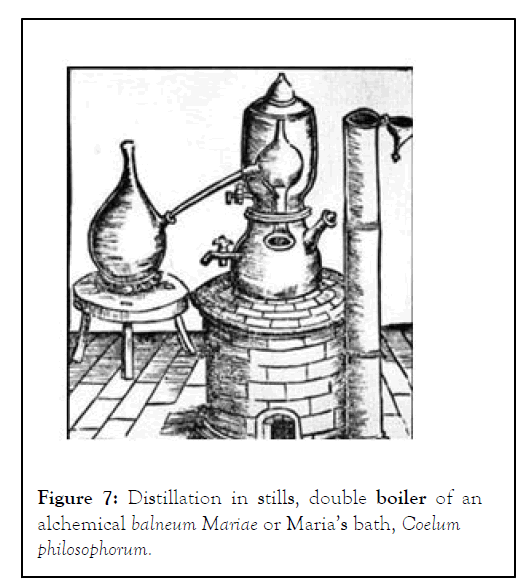
Figure 7: Distillation in stills, double boiler of an alchemical balneum Mariae or Maria’s bath, Coelum philosophorum.
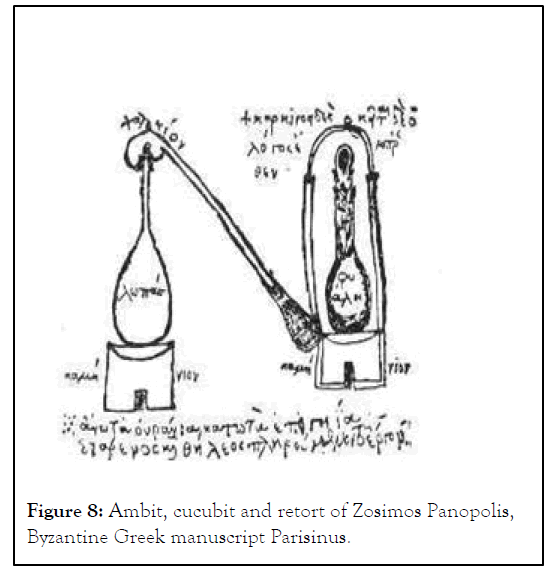
Figure 8: Ambit, cucubit and retort of Zosimos Panopolis, Byzantine Greek manuscript Parisinus.
Discussion about alchemy in Ancient Egypt
Alchemy, derived from kemet, so this etymology could also explain its name “the secret art of Egyptian Black Land”, is a proto-scientist practice and an ancient philosophical and spiritual discipline. Hermes and his caduceus with two intertwined snakes surmounted by wings were the principal symbols of alchemy, (Figure 10) because the staff represents powerthe two snakes are symbols of wisdom, and the wings that of diligence. In the Egyptian Caduceus the winged sun was a symbol associated with divinity, royalty, protection and power (Figure 9) [23,24].
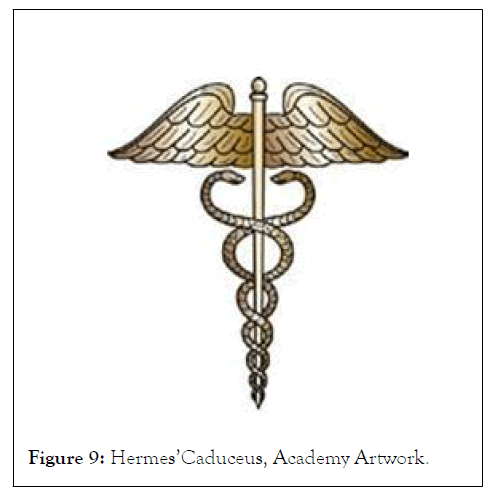
Figure 9: Hermes’Caduceus, Academy Artwork.
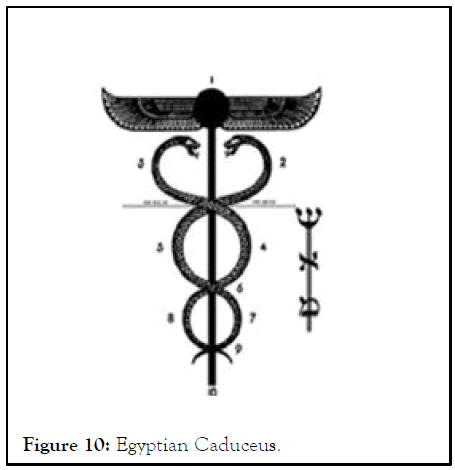
Figure 10: Egyptian Caduceus.
Modern chemistry, which name also derived from kemet, different kinds of metallurgy (the art of extracting metals from mineral ores) and physics were built upon a long history of alchemy; modern chemical industries still use many ancient alchemical substances, tools and processes. In addition, ancient alchemical writings and theories have greatly influenced the Western art and sciences in general: psychology, psychiatry, astrology, esoteric tradition, mysticism and even medicine [25]. Some copper adzes from Naqada Period have been found in Egypt (Petrie Museum, N°5437) as well as other manufactured copper objects. That shows that Egyptians were familiar with chemical analysis and metal production since the Predynastic times. This activity increased during different epochs, adding knowledge and efficiency in substance transformation. Around 4000 BC, Egyptians invented the processes of plaster paste and tanning of leather; they used papyrus in 3000 BC; in 2500 BC cement or mortar appeared in construction of buildings; frit manufacturing about 2000 BC, and glass probably 1500 BC but first of all was cosmetics. In shipbuilding, they used a chemical reaction of calcium oxide and pitch or tar resin.
Reduced to an arcane philosophical system spanning at least 2500 years, Egyptian alchemy is mostly known through the works of ancient authors writing in Greek. It was an art of transmuting metals that had religious dimensions. Alchemical literature, including Zosimus’ writings, often contains polemics against other alchemists, and this illustrates how a variety of “alchemies” were operating and perceived in different time periods. These differences and internal debates should not be overlooked. The spread of a complex network of mystery religions with secret cults, fragmented into a variety of initiation schools throughout the entire world, that attempted to explore the nature of chemical substances and processes, offered a wide range of creativity for the elaboration of miraculous remedies, poisons and magical filters. From the 3rd or 2nd century BC in the Hellenistic Egypt, Greek texts were attributed to the mythical figure of Hermes Trismegistus, who held all the knowledge. It is a heteroclite set of texts (the Hermetica) sometimes alchemical, but also magical, astrological or medicinal, culminating in the mystic-philosophical treatises of the Corpus Hermeticum. This spiritual system was connected to Hermeticism and its roots can be traced to Hermes Trismegistus, a syncretic Greco-Egyptian deity and legendary alchemist, related to the Egyptian god of wisdom Toth and the Greek divine messenger Hermes. He had written 42 Books of Wisdom about all fields of knowledge [27]. Emerald or Hermetic Tablet (Tabula Smaragdina in latin, 12th century), known first through an Arabic translation (6th century, of an Apollonius of Tyana’s Greek version), originally a magical text, later on associated with alchemy, would be the structure of basic laboratory techniques and theory [28], called by his followers Hermetic Philosophy. It emerged as a product of a Greco- Egyptian process of selfperception and as a result of cross-cultural exchange between Greek and Egyptian symbolic universes and will be analyzed according to this historical context, within the formation of a new Greco-Egyptian mentality.
Other disciplines, developing obscure qualities, mysteries and other aspects of occult sciences, had been started throughout Ptolemaic period and became increasingly popular. Alchemy is often labeled as a ‘pseudo-science’ [29] and associated with magic and occultism. The connotations that has alchemy as a form of magic or ‘occult’ pseudo-science belongs to its etymological history and the way it has been portrayed by historians since the XVIII century [30], as an esoteric interpretation of alchemy, and I disagree with the way Principe and Newman (2001; 386) have situated debates over physical and spiritual chemistry solely in a modern historiographical context. Distinctions between technical and spiritual approaches to chemistry can be found throughout the entire history of Western alchemical literature as internal debates between alchemists themselves, and these may have contributed to ‘modern’ interpretations of alchemy [31]. These sciences approached the physical world through the notion of inherent sympathies and antipathies that, after a few generations, gave rise to alchemy and other magical practices. In fact, pseudosciences and various corrupted sciences proliferated in Ptolemaic Alexandria. Every branch of classical science produced its own bastard – the fruit of a decline in scientific originality, accompanied by superstition and philosophical fatalism: from Astronomy, the scientific study of celestial objects and phenomena, gave birth to Astrology and the planetary lore of the horoscope and an idea that individual actions are determined by the stars; Physics, “aided by current notions regarding the kinship and interaction of created things gave birth to Alchemy” and even Medicine was subordinated to astral beliefs, but at a very low level. Like astrology, alchemy is a result of the encounter between the Greek and Egyptian cultures that flourished in Alexandria in the beginning of our era. The earliest developments of this path probably occurred in that Capital, Alexandria, where these superstitions encroached on scientific thought, although the origin and precise dating of Greek philosophers late texts are difficult (Fraser, 1973; 434-435) because of the almost complete absence of earliest Hellenistic texts.
Even if the ambiguity of alchemical technology, processes and objectives need to be clarified, three main goals have been underlined in their activities: the transmutation of common metals into noble metals as gold (chrysopoeia), the creation of the fable Philosopher’s stone and later in the Middle Age, even though built upon the work of Zosimos, the development of an Elixir of Life or panacea, which would confer youth and longevity, idea promoted by Greek mythology that involved the transmutation of human life [32]. However, the foundational stage called ‘Calcination’, the first of the seven major operations, demanded spiritual purification and personal transformation of the human soul and heart, free of defects and impurities. The alchemist himself, according to the ‘esoteric’ approach or ‘spiritual alchemy’ proposed by the Egyptian Zosimos of Panopolis had to improve his nature and virtue symbolized his evolution. Paracelsus himself continued with this concept in the Renaissance: “alchemy is the ability to control, purify and transform nature by the living force of the spirit”, and “the life principle, the only real, is expressed in a material external form that is the house in which it resides”.
The focal point of alchemy was the man himself, his regeneration and perfection, for an understanding of his thoughts and feelings and the similarities with the surrounding environment and his unity with the cosmic whole. Through his remarkable mind, he could thus investigate this strange physical world and their universal mysteries. In other words, the human body (microcosmos) is affected by the external world (macrocosmos) but he could control and manage the outside influences in an unconventional way of operating. The four classical elements, earth, air, fire and water-, regarded as corporeal or chemical substances, are compared to the four principles of human existence: physics, psychic, mental and spiritual, and together they formed the strong fifth element. Many Gnostic sects believed, as conceived by Empedocles and developed by Aristotle, that all things in the universe were formed from these four elements. According to Aristotle, each element, ‘naturally’ belonged to its proper sphere to which it would return if left undisturbed. However, true alchemy never regarded these elements as corporeal substances like are they in present days, they were better seen as primary and general differentiated attributes projected into a corporeal amorphous substance, nevertheless, this theory later developed its mystical Alchemy lacked the philosophical depth and insight to grasp the fundamental harmony of the Cosmos. In practical terms this science explored the fire regime system [33] and the substance powers in an alchemic oven. The early masters of the art of alchemical symbolism did not standardize either their symbols or their terms in the Magnum Opus, a table showing the analogies of the three principles in the four worlds. Later Paracelsus simplified the combination of elements. All substances contained three principles, mercury, sulphur and salt, common names for spirit, soul and body. Through different operations and manipulations, alchemists separated each individual component and purified them with its own fire regime, because they recognized four grades of fire, elementary, secret, central and celestial, melting fire for salt and for sulfur and mercury with recurrent and gentle distillations. Purifying them by monitoring planet aspects, the principles were put together again in a new substance charged now with new powers. After long efforts and experimentation, apprentices became ‘enlightened’, first about the vegetal kingdom until they have mastered fire and time regimes, and then they moved to the major arcane, the animal and mineral kingdoms, since the efficacy of a remedy was proportional to natural force of each species. Alchemists assumed that animals owned certain medical capacities and looked for a universal ‘panacea’ that would cure all disease and prolong life indefinitely. They were also dedicated in the mineral kingdom to search the transmutation of base metals into gold and silver and a legendary substance that was believed to represent some hidden spiritual truth or power, the ‘Philosopher’s Stone’. This mystic agent would make possible the evolution from an imperfect, diseased, corruptible and ephemeral state towards a perfect and incorruptible matter. Changing the raw materials by the strength of fire, generation and regeneration of the elemental substances were achieved. All the liquids used in the sacred art are called ‘divine water’, used early by Zosimos and Bolus of Mendes to process several minerals or metals. There are different kinds of ‘divine water’ or ‘sulfur water’ and the alchemist, however, does not specify the different names; he highlights instead the wide range of natural substances that offer similar qualities and produce the same results in dying processes. Christina Viano has recently dealt with several aspects of this subject: on the one hand, the liquid substance seems to be a major philosophical principle that regulates the deep structure of matter; on the other hand, it performs a technical function with regard to the processes of ‘dying’ base metals, which are transmuted into gold or silver by means of its special power. Later they created aqua regia (royal water) to dissolve gold, a highly corrosive mixture of nitric and hydrochloric acids; and aqua fortis (strong water), a nitric acid to dissolve silver but not gold.
Few original Egyptian documents have survived [34], but alchemical texts refer to different tools and substances describing their preparations. Substances, surely not chemically pure, contained impurities which altered the result of the final reaction, making certain recipes chemically incomprehensible. The active ingredients, weak acids mostly diluted, produced slow reactions. The equipment (Figure 11), identical to those of druggists and chemists used later, includes a number of drug containers (ἄγγος, ἀγγεῖον) in Greek names, pitchers (χύτρα, χυτρίδιον), dishes (λοπάς), jars (σταμνίον), pails (κάκκαβος), barrels (πίθος) and cauldrons (λέβης) and some other instruments were kitchen utensils or tools needed to metallurgists, dyers, and painters.
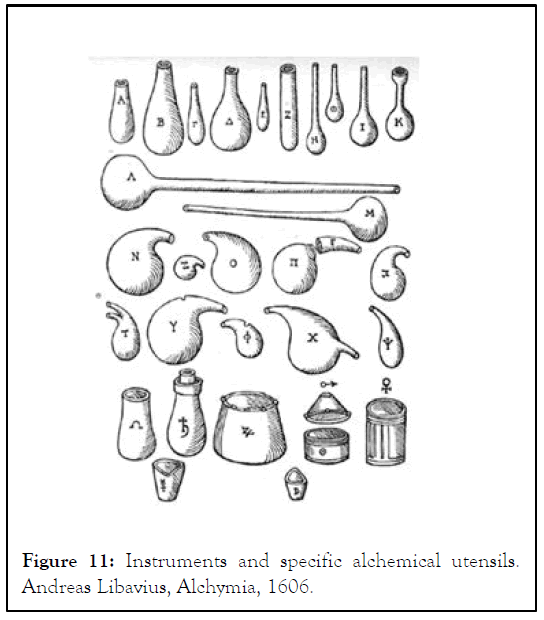
Figure 11: Instruments and specific alchemical utensils. Andreas Libavius, Alchymia, 1606.
The same container made of clay, sometimes of copper or lead or boxwood, had different names in the same recipe [35]. Containers were put in the oven covered with clay (περιπηλοώ) or with a lid (πῶμα), culinary and metallurgical practice.
The clay pots had to be cleaned or covered with insulating materials to avoid absorption of harmful ingredients. Although ovens (κάμινος) were not described, they could have been small crucible furnaces provided with an artificial blower, classic in old metallurgy, heated with straw, wood or charcoal.
Domestic oven (ὀπτάνιον), potter’s kiln, small stove for heating or bath furnace (βαλανεῖον) was sometimes used [36-40].
The specific alchemical instruments were kitchen tools, very rough: tweezers, an iron spatula to stir the mercury products, hard stone mortar for grinding drugs, ivory burnisher, baskets, rags, feathers for brushes, a touchstone, a stylus. The only early invention was kerotakis, created by Mary the Jewess (Figure 12). It was a metal plate heated from below by embers on which painters liquefied their wax breads and was used in alchemy as in painting. Transformed by alchemists into a sophisticated sublimation apparatus in which vapor turned solid without passing through the intermediary liquid phase. Later Paracelsian iatrochemistry emphasized the medical applications of alchemy (continued in spagyrica vegetal or the mysteries of plant alchemy to prepare medicinal essences and in a modern homeopatia) [41-45].
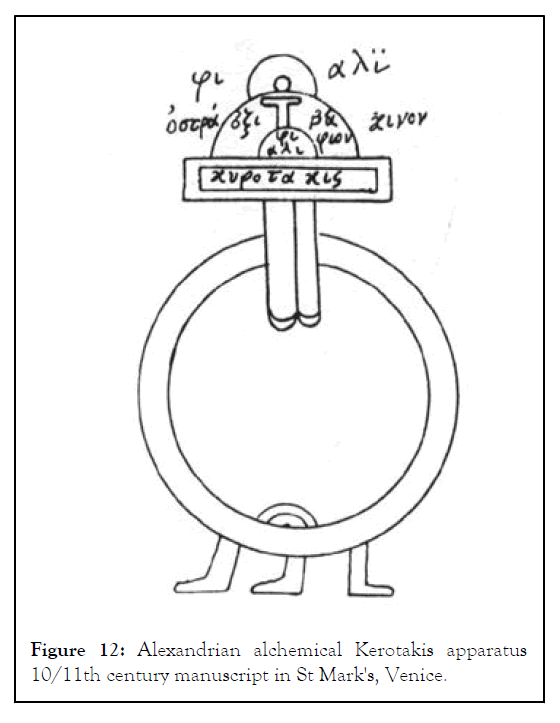
Figure 12: Alexandrian alchemical Kerotakis apparatus 10/11th century manuscript in St Mark's, Venice.
During Greco-Roman period, Alexandria retained its preeminence as a center of alchemical knowledge because the Greeks appropriated hermetic beliefs and melded with them the philosophies of Pythagoreanism, Ionianism and Gnosticism. Pythagoreans and neo-Pythagoreans believed that numbers ruled the world, their conviction originated from the observation of sounds, stars and geometric shapes like triangles, or anything from which a ratio could be derived; Ionian thought was based on the belief that the universe could be explained through concentration on natural phenomena. The best accounts of the first philosopher with practical interests in mathematics, astronomy and biology are quoted by later writers such as Plato and Aristotle. From these quotation fragments, we are left to reconstruct their original views. Ionianism, philosophy originated by Thales and his pupil Anaximander and later developed by Plato and Aristotle, whose works came to be an integral part of alchemy, based upon Aristotle’s cosmology at least in Europe, explained Universe through concentration on natural phenomena, and clarified the world by a few unified laws derived from careful, detailed and exacting philosophical explorations [46]. Gnosticism, prevalent in the Christian Roman Empire, affirmed that this world had been created imperfectly, and that learning about the nature of spiritual matter would lead to salvation. For them a lesser divinity and not the true God, who is beyond all created universes, ‘created’ the universe, corrupted in the process, rather than by original sin and posterior transgressions? Many Gnostic sects rejected the biblical deity as evil and as a fallen emanation from the transcendental God, whom they sought to worship and join. Alchemy had incorporated the ascension to the High God, rejecting the evil aspect of Abraham’s God; and had also taken the Platonic and Neoplatonic cosmological theories about universals and God’s omnipotence. The imperfect physical world was contrasted with God seen as a cosmic and transcendent mind [47-50].
By the end of the Roman Empire, Greek alchemical philosophy became secret leading to the cult of Hermetism (Figure 13), incorporating Egyptian philosophies, with Alexandria as a study center. Christian doctrine, in the opposite line, affirmed that experimental philosophy was an evil influence [51-53]. The Christian philosopher St. Augustine (354-430) condemned also the teachings of Trismegistus as idolatry and under his influence, medieval philosophy stated that alchemy was opposed to God and faith and reason were both the only sources of authority to understand God [54-59].
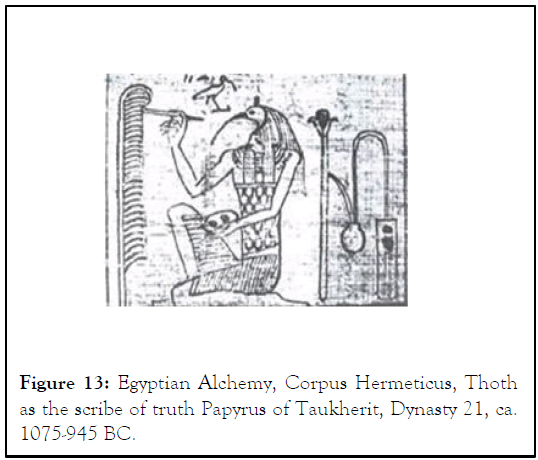
Figure 13: Egyptian Alchemy, Corpus Hermeticus, Thoth as the scribe of truth Papyrus of Taukherit, Dynasty 21, ca. 1075-945 BC.
In the search for hidden knowledge, alchemy and astrology were closely related, one complementary to each other. Traditionally, each of the seven planets (meaning ‘wanderer’ from the Greek πλανήτης), known by the Ancients, Mars, Jupiter, Venus, Saturn, Mercury, the Sun and the Moon, held dominion over, were connected to and ruled one of the seven known metals, gold, silver, copper, tin, lead, iron and mercury [60]. Alchemists believed that the other elemental metals were variants of these seven [61-63]. In Hermetism, the three parts of wisdom were astrology, theurgy and alchemy [64]. Before Ptolemaic times, Egyptian priests had highly developed some aspects of planetary erudition, but in Greece, Eudoxus, Plato’s student, was the first who developed a planetary model using concentric spheres, even though he rejected astrological doctrines [65]. Two different but parallel ways had just appeared in Alexandria by the 2nd BC: one in the broader context of Alexandrian mathematical astronomy and other, following Egyptian priestly traditions. Astrology was related to Stoic philosophy, “for whose notion of an inflexible fate and also of a sympathy among all created things, providing a rigid cosmological background not reflected in the Ptolemaic texts”, and it was a product of exchange between Greek and Egyptian culture. They managed to calculate life expectancy through the zodiac sign values. ‘Brontology’, from Hermes Trismegistus, a writing of Ptolemaic origin, studied storm and thunder meteorology for each month and their significance in terms of ‘universal’ prophecy and apocalyptic forecasts [66]. However the context showed calamities which would befall the land of Egypt and their kings [67]. Two contemporary but more complex astrological texts were written: Hermes Trismegistus on the names and the power of the twelve places and the book of Hermes Trismegistus. The first, a long Hermetic writing quoted by Sarapion of Alexandria from the Empirical School (1st century BC), the Twelve signs of the Zodiac in a specific area of the celestial sphere, in a region or ‘mansion’ where they rest and influenced the individual life [68-70]. The second, clearly based on Imperial Roman sources, incorporated native Egyptian elements in the astrological doctrine, as the use of the decans. This 36 star groups or deities, characteristic of the early Egyptian astronomy, presided in various ways the celestial sphere and the continual passage of time. But in Greek astrology each zodiac sign is divided into three decans with his planetary equivalent, for the Egyptian decans [71-73]. ‘Astrological Medicine’ (ἰατρομαθηματική) grew up from this system, because each astrological sign was associated with a different part of the human body and determined the nature and duration of the disease. ‘Astrological Botany’, another new branch that should be linked closely with the first, established the relationship among medicinal plants, planet positions and the affected organ in order to found out the most effective treatment [74-76].
Other debased sciences, less connected with astrology, began a long career of increasing popularity in Hellenistic times, although they were inclined towards occultism and mystery. In physical sciences, Theophrastus’ and Straton’s scientific thought suffered a temporal abandonment and were replaced by an approach to physics, partly scientific, partly occultist [77-80], “based specially in the sympathy notion which, in the course of a few generations, led to emergence of alchemy and other magical practices”. The prototype for this approach can be found in Bolus of Mendes (or Pseudo-Democritus), a notable and strange figure, active in Alexandria around 200 BC, during Evergetes II’s kingdom. Immersed in the Peripatetic atmosphere of the 3rd century and following the occultism of the late Antiquity and the tradition that harmonized astrology, magic medicine and alchemy, he was very important writer and an ingenious innovator of philosophical language in the decline of Alexandrian and Greek science [81-85]. Being a native of Mendes in the eastern Delta, his merit was to join theory and experiment, product of a mixture of Greek and Egyptian influences. In at least two cases, Bolus must have “adapted Democritus’works, keeping the same titles, though without intent to defraud” Things Wrought by Hands (Хειρόκμητα) and On Potent Natural Drugs (Фυσικά δυναμερά). The last was probably his main work, where he explained his theories about sympathies and antipathies. Both books were determined by herbal pharmacopoeia, the apparently apocryphal Book 9 of Theophrastus, devoted to medicinal values of plants and the continuous remarks on botany and early astrology of Democritus of Abdera [86-89]. This famous disciple of Leucippus of Miletus, great originator of the atomic theory, had written on the nature of man, on pestilential diseases, on prognostics and on the causes of diseases. He played an important role in Bolus’ ideas and the alchemical discourse, who reconsidered magical properties, powers and immanent forces in plants, animals, and gems [90-93]. These three elemental kingdoms, vegetal, animal and mineral, represented the planets, inaccessible to men, in Earth, and were connected through magical ‘sympathy’, manipulating occult forces. The book on sympathies represented the perversion of the Peripatetic paradoxography of the Apollonius’ Mirabilia. He also discarded the Stoic doctrine on universal cosmic predetermined sympathy because this was probably largely cosmological and metaphysical and included crude superstitions about therapeutics and animal behavior [94]. An example is his speech about the persea tree, originally poisonous, transplanted by Persians to kill the Egyptian inhabitants, but the country, that was good-natured, transformed its nature and made it a most sweet plant [95].
In a contradictory alliance between the rational and the irrational, invisible and powerful relationships among all the aspects of nature, the astrological notions of decans’ power predominated, connecting all their vices and virtues. Each decan transmitted a certain disease since each god was associated with a specific disease and each aspect of nature with an illness. Through the teaching of divine rationality, every celestial illness was cured by means of these contrary natures and powers.
The Egyptian materia medica, composed of a great variety of plants, perfumes and metals produced in its own territory and even including foreign products or exotic plants, led as a consequence to the study of the miraculous properties and virtues of simples. Egyptian physicians tried also to evaluate their therapeutic effectiveness through trial and error, notwithstanding Egyptian tendency to polypharmacy.
Egypt, the country of pharmaca, regarded as the cradle of knowledge of stones and their qualities, developed, as a natural result, the diversity and complexity of alchemy, with elements dated back to Pharaonic Egypt where it was the domain of the priestly class. This was the result of a particular historical context, the last period of Ptolemaic Alexandria, a continuous prestigious cultural centre, which had reached unprecedented levels of achievement, unique in antiquity.
The religious and philosophical dimensions of alchemical beliefs was then an expression of his cultural milieu, often inspired by ideas circulating in the culture at large; in this sense, the religious aspects of alchemy can be studied apart from the technical, if we are looking, for example, at Zosimus’s religious views. Zosimus believed that divine revelation, meditation and piety were crucial to his work although both suffered mutual influence and the religious language of alchemy would be decoded into a ‘language of the laboratory’. However it is impossible to situate debates over physical chemistry solely at the beginning because this places the problem in a modern historiographical context.
Set in an ancient and historical background, it can be seen the role of alchemy and astrology in the development of medical theories. Despite the proliferation of pseudo-sciences, Alexandria could still have offered the best academic training available, especially in the Mouseion, a teaching establishment, and the Library, a literary centre of research.
[Google scholar] [PubMed]
[Google scholar] [PubMed]
[Google scholar] [PubMed]
[Cross refer] [Google scholar] [PubMed]
[Google scholar] [PubMed]
Citation: Rosso AM (2023) Therapeutic Pharmaca and Alchemy from Ancient Egypt, the Country of 'Two Lands' (Tauy). J Clin Toxicol. 13:532.
Received: 18-Feb-2022, Manuscript No. JCT-22-14668; Editor assigned: 21-Feb-2022, Pre QC No. JCT-22-14668 (PQ); Reviewed: 07-Mar-2022, QC No. JCT-22-14668; Revised: 01-Mar-2023, Manuscript No. JCT-22-14668 (R); Published: 08-Mar-2023 , DOI: 10.35248/2161-0495.23.13.532
Copyright: © 2023 Rosso AM. This is an open-access article distributed under the terms of the Creative Commons Attribution License, which permits unrestricted use, distribution, and reproduction in any medium, provided the original author and source are credited.